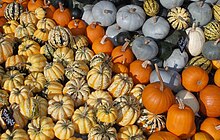| Squash | |
|---|---|

| |
| Cucurbita fruits come in an assortment of colors and sizes. | |

| |
| Cross section of Cultivated Cucurbita of Canada | |
| Scientific classification | |
| Kingdom: | Plantae |
| Clade: | Tracheophytes |
| Clade: | Angiosperms |
| Clade: | Eudicots |
| Clade: | Rosids |
| Order: | Cucurbitales |
| Family: | Cucurbitaceae |
| Tribe: | Cucurbiteae |
| Genus: | Cucurbita L. |
| Synonyms[1] | |
Cucurbita (Latin for 'gourd')[3][4] is a genus of herbaceous fruits in the gourd family, Cucurbitaceae (also known as cucurbits or cucurbi), native to the Andes and Mesoamerica. Five edible species are grown and consumed for their flesh and seeds. They are variously known as squash, pumpkin, or gourd, depending on species, variety, and local parlance.[a] Other kinds of gourd, also called bottle-gourds, are native to Africa and belong to the genus Lagenaria, which is in the same family and subfamily as Cucurbita, but in a different tribe, their young fruits are eaten much like those of the Cucurbita species.
Most Cucurbita species are herbaceous vines that grow several meters in length and have tendrils, but non-vining "bush" cultivars of C. pepo and C. maxima have also been developed. The yellow or orange flowers on a Cucurbita plant are of two types: female and male. The female flowers produce the fruit and the male flowers produce pollen. Many North and Central American species are visited by specialist bee pollinators, but other insects with more general feeding habits, such as honey bees, also visit.
There is debate about the taxonomy of the genus and the number of accepted species varies from 13 to 30. The five domesticated species are Cucurbita argyrosperma, C. ficifolia, C. maxima, C. moschata, and C. pepo, all of which can be treated as winter squash because the full-grown fruits can be stored for months. However, C. pepo includes some cultivars that are better used only as summer squash.
The fruits of the genus Cucurbita are good sources of nutrients, such as vitamin A and vitamin C, among other nutrients according to species. The fruits have many culinary uses including pumpkin pie, biscuits, bread, desserts, puddings, beverages, and soups; they are now cultivated worldwide. Although botanical fruits, Cucurbita gourds such as squash are typically cooked and eaten as vegetables. Pumpkins see more varied use, and are eaten both as vegetables and as desserts such as pumpkin pie.
- ^ "Cucurbita L." Tropicos, Missouri Botanical Garden. Archived from the original on August 7, 2019. Retrieved January 12, 2014.
- ^ "Tristemon". Tropicos. Archived from the original on February 20, 2022. Retrieved January 14, 2015.
- ^ Cite error: The named reference
burrowswas invoked but never defined (see the help page). - ^ Gledhill, David (2008). The Names of Plants. Cambridge: Cambridge University Press. p. 127. ISBN 9780521866453.
- ^ Ferriol, María; Picó, Belén (2007). "3". Handbook of Plant Breeding: Vegetables I. New York: Springer. p. 317. ISBN 978-0-387-72291-7.
The common terms "pumpkin", "squash", "gourd", "cushaw", "ayote", "zapallo", "calabaza", etc. are often applied indiscriminately to different cultivated species of the New World genus Cucurbita L. (Cucurbitaceae): C. pepo L., C. maxima Duchesne, C. moschata Duchesne, C. argyrosperma C. Huber and C. ficifolia Bouché.
Cite error: There are <ref group=lower-alpha> tags or {{efn}} templates on this page, but the references will not show without a {{reflist|group=lower-alpha}} template or {{notelist}} template (see the help page).